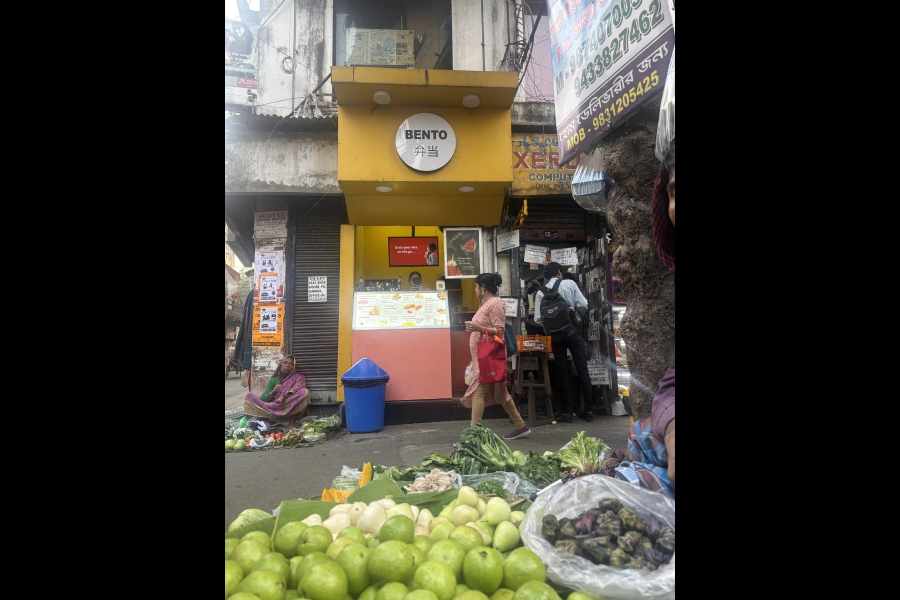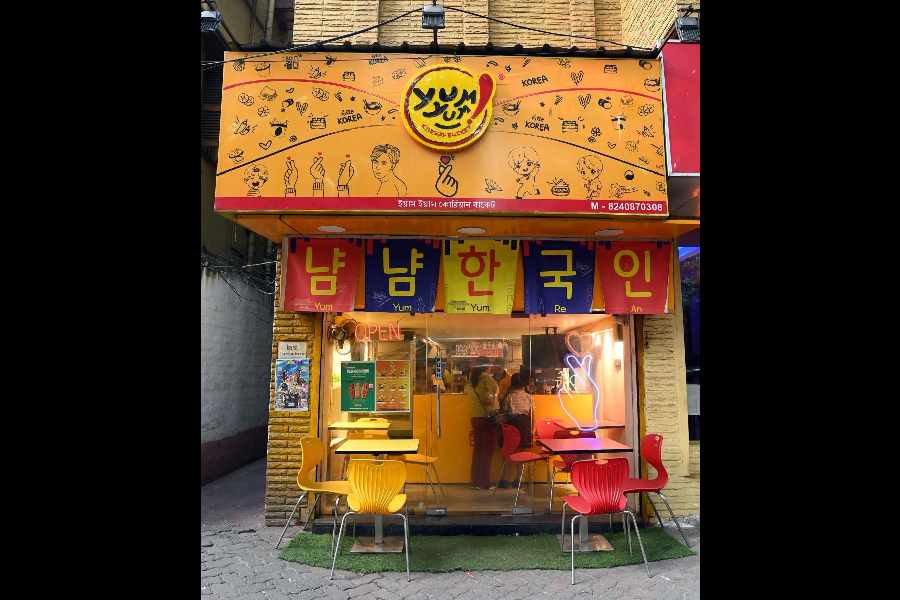There have been different epochs in Calcutta’s fine dining history. The post-Independence period can be broadly divided into Mughlai, Continental and Chinese. But it must be understood that no cuisine ever overrode another; epochs coexisted peacefully as restaurant menus are testimony.
Fast forward to 2024. And the new cuisine on the block is Korean food or K-food.
“Chinese food came to Calcutta by land, but Korean food is a flying trend,” says Anand Puri, a third-generation restaurateur and owner of Trincas on Park Street. According to Shilbhadra Datta who runs the Facebook page “Calcutta Adda n Food”, social media too has something to do with its popularity. “When I try a Korean dish and write about it, those tracking my posts also want to try it,” he says. “It’s almost like peer pressure that trickles down digitally.”
It’s true, K-food has flown in borne on social media and OTT platforms, following in the footsteps of K-drama, K-pop, Korean beauty products and, of course, Korean celebrities.

Tov Korean restaurant. Pic: Rashbehari Das
Sudarshana Ganguly, 24, who is from Calcutta but has recently moved to Hyderabad, says, “In one of my favourite K-dramas, Extraordinary Attorney Woo, the protagonist’s father owns a kimbap shop and every morning she eats kimbap before going out. It gave me such a craving for it even before I tasted it.” Kimbap or gimbap is basically Korean sushi.

Bento Korean restaurant. Pic: Rashbehari Das
Anoushka Marak, 23, a primary school teacher in Howrah, says, “I love the scene from A Business Proposal in which the lead couple cooks chicken wings together. They make the chicken crispy by adding powdered brown rice and then dipping it in some kind of sauce and curry. It definitely made me hungry.”
Both Extraordinary Attorney Woo and A Business Proposalare K-dramas streaming on Netflix India.
There must be something to it or the OTT platform would not have kept adding K-food shows galore such as A Nation of Banchan, A Nation of Broth, A Nation of Kimchi, Jjajangmyeon Rhapsody, Korean Fried Chicken Rhapsody and even Korean cook-offs. Banchan is the name for the side dishes that accompany a Korean meal; jjajangmyeon is Korean noodles made with a thick special sauce and kimchi refers to a preparation of fermented vegetables.

Tov Korean restaurant. Pic: Rashbehari Das
Not just shows, Amazon India stocks English translations of Korean titles such as I Want to Die but I Still Want To Eat Tteokbokki. Tteokbokki is stir-fried rice cakes, tossed in sweet, spicy and tangy sauces.
Urvika Kanoi, who is a chef and restaurateur, says, “Only a few days ago, I was browsing Zomato for some noodles options at 3am and an eatery called Maggi Wala popped up. It was selling different flavours of Samyang noodles.”

Korean food. Pic: Rashbehari Das
Samyang is an instant noodle brand from a South Korean company. And yes, it is commonly found in Calcutta, no matter that it costs four times the price of a packet of noodles by Indian manufacturers.
Those in the know will tell you about the demand for packed K-food items as well as K-food ingredients in Calcutta.
But mind you, in this case, Calcutta is not bucking the trend. The buzz is north Bengal has been enjoying K-food for some time now.
Surabhi Pakhrin, 23, a resident of Siliguri, rattles off names of K-food cafes and eateries in her hometown. She knows her bento box from her kimchi fried rice, savours Korean fried chicken and that bowl of ramen. A Korean bento box contains rice and a variety of side dishes. She buys Korean snacks such as rice crackers, shrimp crackers, seaweed and various spices and sauces from a stall at Hong Kong Market, and will tell you that she recently found corn dogs at Gorkhay Haat, which is a local Sunday market in Siliguri.
Argho Mukherjee, who owns a street food chain in Calcutta called Yum Yum Korean Bucket, says, “Even three years ago, we faced a shortage of ramen noodles because our suppliers would send most of their Samyang noodles to north Bengal.” Ramen is a generic name for pulled noodles, a type of soft wheat flour noodle made by hand — by twisting, stretching and folding dough into strands. But now, Samyang ramen is easily available in most supermarkets. Retail chain Spencer’s has entire aisles dedicated to K-food in its city outlets. A K-food-themed grocery store called K-Food Antenna Shop opened up in New Town recently.
Cafe Tov and Seoul Restaurant are in Ajaynagar. The same Ajaynagar that is in the southern extremity of Calcutta, a fairly recently developed part of the city dotted with hospitals and housing societies, highrises, malls, shopping complexes and educational institutions. No, Ajaynagar is not Park Street.
A Korean couple in their late fifties, Oksoo Im and Hosea Kim, started Cafe Tov six years ago. They have been living in Calcutta for three decades now.
Cafe Tov debuted at a time when India was riding high on the waves of Korean culture. King’s Bakery opened in 2018. Yum Yum Korean Bucket in 2022. Soy Yum opened earlier this year. Today, there are about 20 popular K-food eateries in Calcutta.
Each place has its own USP. Cafe Tov’s is authenticity. Most of the customers are regulars, many of them Koreans. Jiwoo Sung, 27, works at the Korean Trade and Investment Promotion Agency. She says, “I live in New Town; I come here once every four months.” She comes for the jjajangmyeon.
Then there is Shim jea Keim. She has been in India for almost 13 years and has recently opened a salon close to Cafe Tov. Herfavourite item on the menu isthe kimchi jiggae set, a pork-based dish. Smile Kim and her husband Joshua Sung, who owns a travel agency in the city, always order the chicken dakdoritang, osam bulgogi set and kimchi fried rice. Joshua says, “It tastes a lot like home.”
Argho Mukherjee’s strategy has been to aim for the youth diner, college students with their penchant for all that is new and trendy and eminently Instagrammable. His Yum Yum Korean Bucket sells corn dogs, Korean fried chicken and boba tea or tea topped with chewy tapioca pearls. At present, Mukherjee has four outlets in Calcutta, one in Guwahati and one in Bhubaneshwar.
Pravakar Konzone has started a Korean barbecue in the Salt Lake branch of Momo I Am and at Soy Yum on Southern Avenue.
More and more street shops are offering corn dogs dipped in cheese and mayonnaise, and Korean burgers made of chicken keema coated with an assortment of sauces.
Kanoi says, “When a new cuisine wants to become massy, it has to acquire some desi tadka”. But King’s Bakery and Seoul Story owner Peter Jung Seok is worried about the authenticity of what passes as K-food in Calcutta. He says, “Nowadays, people simply add gochujang sauce to items and call it Korean food.” He worries K-food would pick up in Calcutta but only as Indo-Korean food, just like Chinese food did.
Owner of Cafe Tov Oksoo Im admits that non-availability of Korean ingredients is a hurdle when it comes to maintaining authenticity. Her kimchi during the summers is usually made of papaya rather than Chinese cabbage. She will tell you how she cannot find herbs such as minari, ssukgat, daepa, and has to scout around for alternatives.
Roshni R. Sood, executive chef and partner of Poach Kitchen, says, “K-food has had an easy run in Calcutta so far as much of its taste and ingredients are already so familiar. It has everything that Bengali people already like — spice, tang, meat, rice and vegetables.”
Mukherjee’s take: “It is not yet a massy street food but in the next 10 years, I see a huge potential for K-food in India.”
The wise Oksoo Im won’t hazard either theory or prophecy. When asked why K-food had suddenly become so popular here, she says, “Ami toh janina, kintu onek dhonnobad.”
And it’s a wrap.









